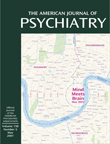Acute Visual Loss After Thioridazine Overdose
Mr. A, a 29-year-old man, was admitted to the emergency department while unconscious. He had ingested in excess of 1500 mg of thioridazine with a moderate amount of alcohol. Two years before this hospitalization, he had been maintained with thioridazine, 100 mg/day, to treat a psychiatric illness. On admission his blood pressure was 90/50 mm Hg, and his pulse was 110 bpm. The next morning, before further assessment, he left the hospital. He visited his general practitioner 11 days later complaining of decreased vision since the overdose and was referred for ophthalmological assessment.His visual acuity was 3/60 in the right eye and 2/60 in the left eye. His pupils were dilated, and he had a sluggish, minimal reaction to light. A fundoscopy revealed poorly perfused retinal arteries with diffuse retinal edema and bilateral cherry-red maculae that were consistent with central retinal artery nonperfusion. The results of a Goldmann field test showed that his visual field was constricted to a central island. These findings were unchanged at a review conducted 1 week later. Fundus fluorescein angiography showed arterial and venous nonperfusion with poor choroidal perfusion. Subsequently, Mr. A failed to return for follow-up and electrodiagnostic tests.
References
Information & Authors
Information
Published In
History
Authors
Metrics & Citations
Metrics
Citations
Export Citations
If you have the appropriate software installed, you can download article citation data to the citation manager of your choice. Simply select your manager software from the list below and click Download.
For more information or tips please see 'Downloading to a citation manager' in the Help menu.
There are no citations for this item
View Options
View options
PDF/ePub
View PDF/ePubGet Access
Login options
Already a subscriber? Access your subscription through your login credentials or your institution for full access to this article.
Personal login Institutional Login Open Athens loginNot a subscriber?
PsychiatryOnline subscription options offer access to the DSM-5-TR® library, books, journals, CME, and patient resources. This all-in-one virtual library provides psychiatrists and mental health professionals with key resources for diagnosis, treatment, research, and professional development.
Need more help? PsychiatryOnline Customer Service may be reached by emailing [email protected] or by calling 800-368-5777 (in the U.S.) or 703-907-7322 (outside the U.S.).

